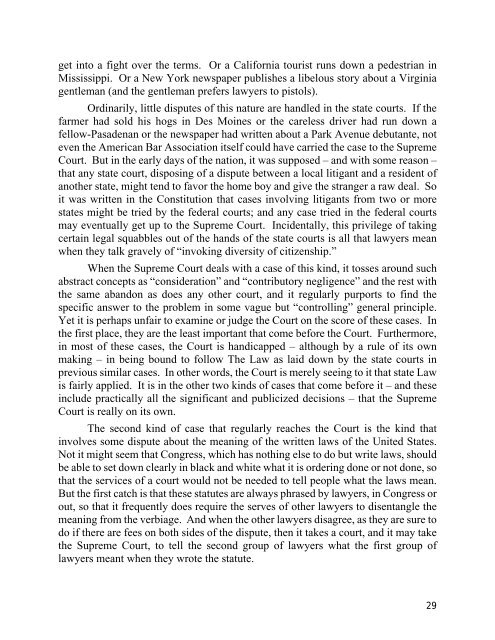WOE UNTO YOU, LAWYERS!
WOE UNTO YOU, LAWYERS!
WOE UNTO YOU, LAWYERS!
You also want an ePaper? Increase the reach of your titles
YUMPU automatically turns print PDFs into web optimized ePapers that Google loves.
get into a fight over the terms. Or a California tourist runs down a pedestrian in<br />
Mississippi. Or a New York newspaper publishes a libelous story about a Virginia<br />
gentleman (and the gentleman prefers lawyers to pistols).<br />
Ordinarily, little disputes of this nature are handled in the state courts. If the<br />
farmer had sold his hogs in Des Moines or the careless driver had run down a<br />
fellow-Pasadenan or the newspaper had written about a Park Avenue debutante, not<br />
even the American Bar Association itself could have carried the case to the Supreme<br />
Court. But in the early days of the nation, it was supposed – and with some reason –<br />
that any state court, disposing of a dispute between a local litigant and a resident of<br />
another state, might tend to favor the home boy and give the stranger a raw deal. So<br />
it was written in the Constitution that cases involving litigants from two or more<br />
states might be tried by the federal courts; and any case tried in the federal courts<br />
may eventually get up to the Supreme Court. Incidentally, this privilege of taking<br />
certain legal squabbles out of the hands of the state courts is all that lawyers mean<br />
when they talk gravely of “invoking diversity of citizenship.”<br />
When the Supreme Court deals with a case of this kind, it tosses around such<br />
abstract concepts as “consideration” and “contributory negligence” and the rest with<br />
the same abandon as does any other court, and it regularly purports to find the<br />
specific answer to the problem in some vague but “controlling” general principle.<br />
Yet it is perhaps unfair to examine or judge the Court on the score of these cases. In<br />
the first place, they are the least important that come before the Court. Furthermore,<br />
in most of these cases, the Court is handicapped – although by a rule of its own<br />
making – in being bound to follow The Law as laid down by the state courts in<br />
previous similar cases. In other words, the Court is merely seeing to it that state Law<br />
is fairly applied. It is in the other two kinds of cases that come before it – and these<br />
include practically all the significant and publicized decisions – that the Supreme<br />
Court is really on its own.<br />
The second kind of case that regularly reaches the Court is the kind that<br />
involves some dispute about the meaning of the written laws of the United States.<br />
Not it might seem that Congress, which has nothing else to do but write laws, should<br />
be able to set down clearly in black and white what it is ordering done or not done, so<br />
that the services of a court would not be needed to tell people what the laws mean.<br />
But the first catch is that these statutes are always phrased by lawyers, in Congress or<br />
out, so that it frequently does require the serves of other lawyers to disentangle the<br />
meaning from the verbiage. And when the other lawyers disagree, as they are sure to<br />
do if there are fees on both sides of the dispute, then it takes a court, and it may take<br />
the Supreme Court, to tell the second group of lawyers what the first group of<br />
lawyers meant when they wrote the statute.<br />
29


